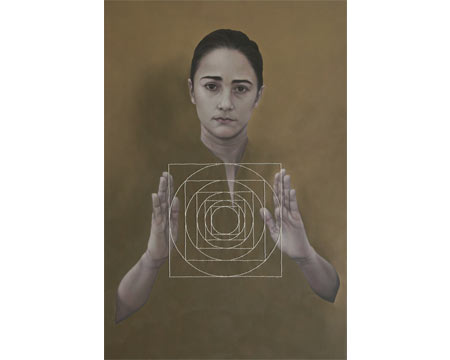
Paintings and photographs by Aimée García and Carlos Montes de Oca focus in her case on a re-viewing of the self, and on the re-contextualization of space in his. Both are mid-career artists who live and work in Havana, Cuba, and both have exhibited in this country, in Mexico and abroad. But the aesthetic territory that both artists inhabit lies beyond geographic and national boundaries. For García it is a space culturally consigned to the concept of “woman.” For Montes de Oca, that territory lies within the perceptual boundaries of time and space. Both are restless to break free of the given constraints associated with the constructs they investigate. This exhibition could be titled “Two Artists in Search of New Spaces,” or “Journeys and Encounters.” However, the simple given title “Two Cuban Artists” references more than nationality. It reminds us of a political reality that today continues to include arbitrary communication barriers, ranging from simple emailing and shipping logistics to visas denied, all routinely challenging those who make the effort to show Cuban art.
García’s confrontation with herself as both image and object marks the course of her entire career. Painted surfaces range from monochromatic works that feature single or multiple self portraits that may appear in profile contemplating a doll or her double, or holding a mirror which in turn reflects her face. In others the artist joins the viewer in the contemplation of her multiple backs. García also sometimes substitutes people for objects linked with women’s labor. She fabricates a magnificent table setting of a crocheted table cloth, settings and pitchers, all knitted out of metal wire. There are paintings of pressure cookers about to explode.
This work is expansive in its aesthetic points of reference, evoking classic Renaissance portraits as well as bits and pieces of objects and attire that range from the contemporary to the Asian. Her vision goes beyond her selfhood to convey a broader consciousness of what women everywhere face today: In a statement for this exhibition, she asserts her dedication to painting as the “protagonist” of these works, as well as her focus on the use of materials such as thread, iron, and hair encouraging viewers’ thoughts about “life history, memories and death.” These materials and their use elicit for her, the “contradictory feeling of women.” On the one hand there is the historically oppressive burden of labor these imply, then there is the contrasting “pleasure of doing so for their family and society.”
Her new series “Cosmos,” on view here, features self-portraits in which the artist grasps wire shapes. In one, a wire rectangle is constructed of circles and squares, a labyrinthine form whose center is fixed on the region of her heart. Her open neckline subtly descends in a triangle toward this circle. Merged with this cosmic analogy of ‘eternal’ Platonic forms, Garcia expresses a oneness with that world and conveys a sense of power that it such an ordered universe can impart. In a quarter profile portrait, holding what could be a Greek cross, circles and squares reference the four cardinal points. García bonds herself to a magical and mysterious world through a cosmos of signs and symbols of her own invention.
If Garcia’s world is focused on the self-image and its encounters, painter-printmaker Montes de Oca’s spatial explorations relate narratives inhabited by quasi-anthropomorphic figures, cyber beings, animals and multiple signs and abstractions. They illustrate seemingly quotidian activities, but which occur in dissonant contexts. For this exhibition, Montes de Oca sticks with photography, creating an installation of nine photographs (each 61 x 91 cm) entitled “Zen Sentido” (translated, heartfelt or deeply felt Zen) that focus on a herd of goats walking through a gallery space, actually, La Casona, in Havana. As the artist states: “Originally, all the photos shown in the context where they were shot come together as an installation that plays with our senses in order to re-contextualize the gallery space.”
As we view the photos successively, we see images of the goats walking through the gallery space, interacting among themselves, inhabiting and occupying the gallery space with all the familiarity of home. Next we view photographs of viewers in the same gallery, occupying the same space, interacting among themselves and looking at photographs of the goats that were earlier in the same space that they now occupy. Heartfelt indeed.
Published courtesy of ArtScene ©2010
